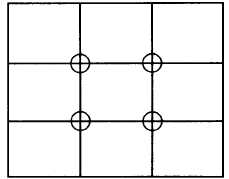Once a stringer system is in place, provide feedback
to the stringers in the form of recognition for good work
and constructive criticism that will help them improve.
A by-line in the paper is the best payment a stringer can
receive.
MORGUE
The morgue, at a minimum, should be a file of back
issues of your newspaper for the past year. The morgue
serves as a collection of back stories that a staff writer
can refer to when doing similar stories for upcoming
issues. It also can provide background and depth for
upcoming stories. A good morgue can often save a writer
hours or days of research.
PRINT SELECTION
Learning Objective:
Outline the procedures for
selecting prints for publication.
There is more to selecting prints for publication than
simply picking the pictures that communicate best.
Many an editor has found himself in hot water because
he did not look at a picture long enough or close enough
to see a hidden “land mine.”
INITIAL STEP
When selecting prints for publication, you should
first narrow down the field. Identify and eliminate what
are considered unusable prints; out-of-focus, over- or
underexposed and poor composition photographs are
among the obvious eliminators.
Base your photograph selections on print quality
and cutline information. When feasible, check both the
contact sheets and the prints made from them when
selecting photographs.
CONTACT SHEET SELECTION
Using a magnifying glass, look for the best negative
to support the story on the contact sheet. Keep these
rules in mind when you examine the contact sheet:
. The photograph should be composed to follow
the “rule of thirds.” In the rule of thirds, the
intersection of lines that divide the picture area
into thirds (fig. 7-4) are good locations for the
center of interest in most photographs. (Make
sure there is only one center of interest to a
picture. Keep it simple.)
Figure 7-4.-Rule of thirds.
Analyze the lines of force, directions toward
which the subject is moving or looking and the
points of interest.
Make sure the subject is identifiable in at least a
three-quarter frontal view. Eyes should be open
and looking at the point of interest.
Do not select photographs that show sailors out of
uniform, not neatly groomed, drinking alcoholic
beverages, in classified areas or settings and in poses
that make the sailor appear less than professional. Also,
avoid using pictures of handicapped people or hospital
patients without their consent (a signed patient release
form).
READ THE STORY
If you are selecting one photograph to accompany
a story, read the story and select a photograph that can
stand alone and tell as much of the story as possible. The
picture should capture the essence of that story. If you
are selecting several photographs, again read the story
for content, thrust and emphasis. All photographs should
complement the story and entice someone to read it. The
photographs must directly relate to the story.
SELECT THE PRINT
The final photograph selection stage is a good
opportunity to catch deficiencies not noticed when
reviewing the contact sheet. For example, the following
background problems may surface:
l
l
Obscene gestures, people in embarrassing
situations, safety violations and security, policy
and propriety violations
Sailors sleeping in, under or on a piece of
equipment
7-11



